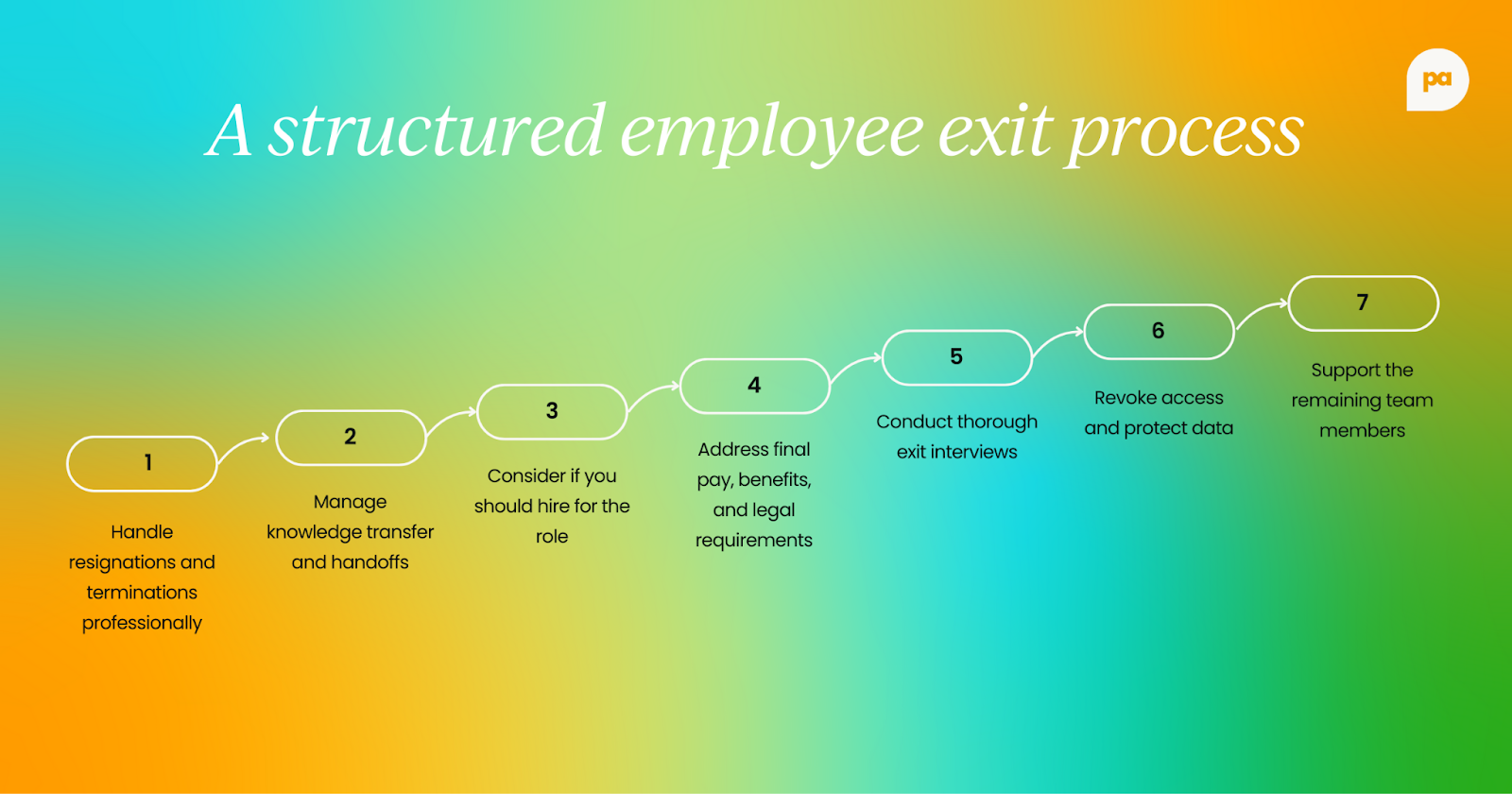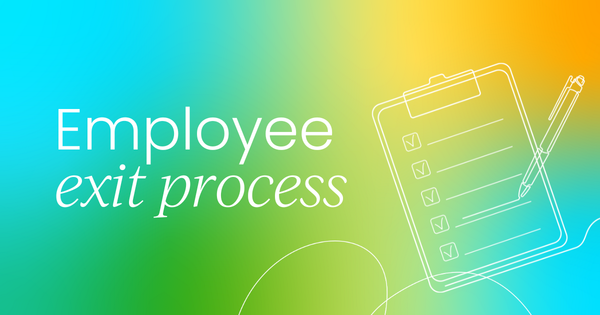Did you know only 29% of companies have a formal employee exit process, compared to 58% that have a formal onboarding process in place?
And yet, implementing a strong exit process has many benefits for your company. Among others, it helps:
- Protect your company culture
- Preserve knowledge
- Keep morale high for the team that stays
- Ensure daily operations run smoothly
- Show employees that they’re truly valued
Preparing for an employee exit before it happens
As an HR professional, you should have a documented offboarding plan well in advance that covers every scenario (from voluntary resignations to retirement, layoffs, and terminations for cause), rather than scrambling when someone resigns or is let go.
From day one, employees should know what to expect if they leave, including notice periods and final paycheck timing.
Managers should be trained on these protocols so the employee exit process remains consistent and professional, no matter who oversees it.
You must also identify key stakeholders ahead of time (e.g., IT and Finance) so everyone knows what’s expected of them.
Having defined responsibilities reduces confusion when someone leaves the company. For instance, IT needs to know when to remove system access while Finance must be ready to issue a final paycheck.
Planning early cuts down on disruption and keeps you and your company compliant.
After all, when an exit is handled poorly, it can hurt productivity and even open the door to legal issues.
“Offboarding matters just as much as onboarding. How you treat people when they go not only says everything about your culture, but it also leaves a lasting impression that will stay with them potentially forever. And that impacts your brand, reputation, and EVP.” – Jo Coxhill, Internal Communication, Employee Experience and Organisational Culture Consultant at Vision 29
Let’s look at this in more detail.
1. Handle resignations with professionalism
When an employee resigns, the clock starts on a series of tasks you must do, and how you respond sets the tone for the exit.
Start by acknowledging the resignation immediately and thanking the employee for their contributions. A meeting, rather than an email, is much more appropriate.
Not only is it more personal, but it also lets you talk about timelines, remaining projects, and how to share the news with the team.
Part of your HR duties is to clarify the notice period and confirm the final workday, as well as outline responsibilities for knowledge transfer so essential tasks and information don’t slip through the cracks.
Showing respect and appreciation is crucial: even if the employee joins a competitor, a supportive exit experience can leave them speaking well of your company long after they’ve gone.
1.5 Navigate terminations and layoffs sensitively
Involuntary exits, whether due to performance, restructuring, or financial pressures, require extra sensitivity and careful planning. A strong employee exit strategy handles the emotional impact while reducing legal and operational risk.
Documentation matters: any performance concerns the company has must be well recorded, and termination decisions should have clear, objective reasons. This isn’t just fair; it also helps prevent disputes.
When sharing the news, choose a private, neutral setting and keep the conversation clear and respectful.
Handling these moments with empathy helps your company to maintain a positive reputation and reassures remaining employees that they’re valued.
“If the process ever feels routine or easy, if the sinking feeling in my stomach doesn’t show up, I’m in trouble. If you are feeling that gut-wrenching feeling, you’re doing it right. Losing that feeling, for me, would mean that my capacity for empathy has been diminished, and in HR, empathy is everything.” – Amanda Duff, HR Director at Now What HR
2. Manage knowledge transfer and handoffs
As suggested above, your employee exit process should include a detailed plan for knowledge transfer to avoid disruptions on projects or with clients.
Start by identifying ongoing projects, key contacts, and critical processes the departing employee manages.
Have them create documentation (e.g., step-by-step guides, login credentials, and client notes) and arrange shadowing sessions or training for the new hire or teammates who will be taking over responsibilities.
You should schedule this transition well before the final day so there’s time for questions and clarifications.
If you take a methodical approach, you can more easily build trust with employees and clients alike.
3. Consider whether you should hire for the role
When an employee leaves, it’s tempting to post the job right away, but an exit is also a natural moment to pause and re-evaluate.
Ask whether the role still fits the company’s current strategy and workload. Some responsibilities may be outdated, better handled through automation, or easily redistributed among the team.
Weigh the full cost of recruiting and onboarding against the potential savings or efficiencies of restructuring. You should also consider whether combining duties with another role will create more value.
4. Address final pay, benefits, and legal requirements
Financial and legal details must be handled accurately. As HR, you must issue a final paycheck on time and in line with local labor regulations, including accrued vacation, overtime, and any other outstanding pay.
You must also explain how benefits like health insurance, retirement plans, and stock options will be handled after employment.
Of course, you also need to collect company property (laptops, ID badges, credit cards, keys) and provide necessary documents such as tax forms, severance agreements, and non-disclosure confirmations.
5. Conduct thorough exit interviews
Exit interviews are important for uncovering insights about culture, management, and satisfaction.
93% of employees believe that their exit feedback is important, so make sure to approach these interviews with genuine curiosity to reveal trends that might otherwise stay hidden.
Schedule the interview during the employee’s final week, ideally with HR rather than their direct manager to encourage openness, and keep it conversational and focused on constructive feedback.
Useful questions include:
- What motivated your decision to leave?
- How would you describe your relationship with your manager and team?
- What changes would make the company a better place to work?
You must listen actively and avoid becoming defensive if the employee has a less-than-positive message to convey; use these insights to turn resignations into opportunities for improvement.

6. Revoke access and protect data
Data security is a critical part of any exit plan. Before an employee’s final day, IT should methodically revoke access to email, cloud storage, internal communication channels, and third-party tools.
Just as important is securely transferring key files, passwords, and system credentials to other team members to help prevent data loss.
These measures keep your sensitive information safe, and allow you to keep things running without hiccups (which becomes even more important in high-stakes industries like healthcare or finance).
7. Support the remaining team members
When someone leaves, their coworkers feel it too; to keep morale and productivity steady, it’s crucial that communication is open and honest.
As an HR professional, you should hold a team meeting to explain the departure to coworkers without sharing any confidential details, and managers should outline how/if at all, responsibilities will shift.
Don’t shy away from acknowledging the departing employee’s contributions publicly as well (when appropriate) and reassure the team about next steps.
This is also your moment to address workload concerns and invite employees to share their thoughts. By doing this, you create trust and stability and show that leadership is attentive and proactive during times of change.

Employee offboarding software
Modern HR tools can make the employee exit process a lot simpler. Automated checklists, e-signatures, and integrated platforms help you not miss or overlook anything.
Incorporating systems like these can streamline workflows and reduce human error. For example, platforms that combine HR and payroll can sort tasks like final pay and exit interview scheduling quickly, accurately, and in real time.
Here are some examples of HR tools:
TL;DR
A strong exit process is more than a checklist. It reflects an organization’s values and professionalism.
By planning every step, treating all employees with respect (whether they’re staying or leaving), and learning from feedback, you can turn endings into opportunities for growth.



 Follow us on LinkedIn
Follow us on LinkedIn
